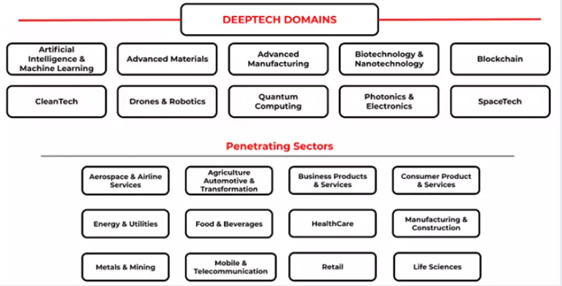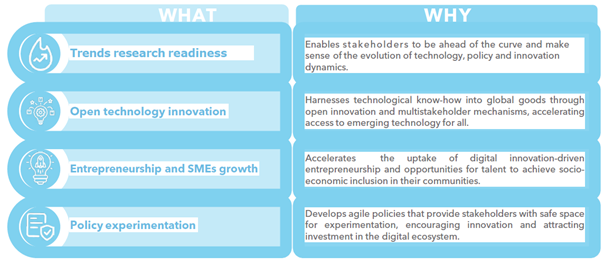BACKGROUND
A digital innovation divide splits countries into digital haves and have-nots. In the latter, talent is unfulfilled, Small and Medium Enterprises (SMEs) are struggling, and the slow digital transformation of economies and communities affects livelihoods and the achievement of development goals. Countries need access to a more resilient and forward-thinking approach along with cutting-edge innovation at their fingertips, which entails developing new capabilities and localizing these capabilities for sustainability.
The Asia-Pacific region is widely seen as a dynamic digital hub. However, there is a divide in the region between those countries that are top performers globally and those whose digital ecosystem is relatively nascent. The region hosts top performers including China and India, as well as 23 Member States that can be considered LDCs, LLDCs, and/or SIDS among the 39 Asia-Pacific Member States covered by the International Telecommunication Union (ITU).
India, in particular, has experienced remarkable growth in the digital innovation ecosystem. From its earliest days as an outsourcing hub, India has been racing up the Global Innovation Index produced by the World Intellectual Property Organization (WIPO), and, in 2022, was 40th in the world and an impressive rank 1 among lower middle-income group economies and in the Central and Southern Asia region.(1) That innovation culture has created fertile ground for start-ups. According to India's Economic Survey 2021-2022, India is now estimated to have the third-largest start-up ecosystem in the world, with 83 Indian startups valued at more than $1 billion. Additionally, Delhi has replaced Bangalore as India's startup capital, with 5,000 recognized startups added in Delhi vs 4,514 startups added in Bangalore from April 2019 – December 2021.
 India's strengths are further highlighted through the rising Deep Technology (DeepTech) and sectoral strengths in digital innovation, per the graphic above.(4) Despite these strengths, stakeholders in the India digital technology innovation ecosystem can face the following barriers: 1) Adapting to the fast-changing global digital environment; 2) Becoming an effective adopter of emerging digital technologies; and 3) Becoming a driver of digital innovation that creates socioeconomic impact globally, beyond the domestic market.
India's strengths are further highlighted through the rising Deep Technology (DeepTech) and sectoral strengths in digital innovation, per the graphic above.(4) Despite these strengths, stakeholders in the India digital technology innovation ecosystem can face the following barriers: 1) Adapting to the fast-changing global digital environment; 2) Becoming an effective adopter of emerging digital technologies; and 3) Becoming a driver of digital innovation that creates socioeconomic impact globally, beyond the domestic market.
These challenges are also replicated in both the Asia-Pacific and global region, especially regarding the digital innovation divide. UNCTAD's 2020 Technology and Innovation Report highlighted the fear of widening technological gaps, with developed countries adopting frontier technologies, reducing the labor-cost competitiveness of developing countries, including in Asia. Their Frontier Technologies Readiness Index showed that Asia's average score was at the world average, below 0.5 out of 1.Among the 46 countries included in the report as Asia and Oceania, 11 of them were placed in the lowest 25 percent quartile, while 10 were in the top 25 percent quartile.(6) There remains a distinctive digital innovation divide in readiness to adopt frontier technologies and innovation in the region.
In response, ITU has launched the Innovation and Entrepreneurship Alliance for Digital Development (Alliance). This initiative is in line with Resolution 90 on 'fostering telecommunication/ICT-centric entrepreneurship Digital innovation ecosystems for sustainable digital development', and Resolution 89 on 'Digital Transformation for sustainable development' adopted by the last World Telecommunication Development Conference (WTDC-22) held in Kigali, Rwanda in 2022. It offers a new approach to bridging the Digital Innovation Divide and empowering ITU-D membership to overcome challenges on their path through digital transformation – unlock their digital potential, build local capabilities in innovation and entrepreneurship, and accelerate their ecosystems' impact on cross-cutting sectors for an inclusive and sustainable society.
The Alliance will enable transformational projects, fostering digital innovation and entrepreneurship for national, regional and global impact. It will help strengthen countries' capabilities to integrate ICT innovation into national development agendas and build humTo navigate the changing environment, stakeholders need to fast-track four strategic objectives to enable acceleration of ecosystems:an and institutional capabilities.
To navigate the changing environment, stakeholders need to fast-track four strategic objectives to enable the acceleration of ecosystems.
